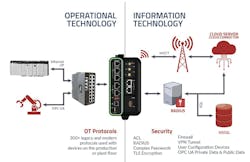Protocol Conversion: Industrial Automation’s Universal Translator
Aug. 27, 2024
4 min read
Artificial Intelligence (AI) is transforming industrial automation with robotics, smart factory equipment and programmable systems. However, the cost efficiencies and performance gains AI delivers are not limited to the production line. Business leaders recognize that every piece of an automated industrial system generates valuable data. They’re eager to deliver that data to enterprise AI systems that can analyze it and feed it back to optimize performance. Those benefits include reducing downtime, enhancing plant safety, bolstering predictive maintenance efforts, increasing energy efficiency and delivering top quality product.
Even though automation engineers and system integrators have a front row seat on new technology in industrial processes, they’re also well aware that legacy equipment remains an important cornerstone on shop floors around the world. The challenge of bringing in new automation technology is often not the technology itself. Often the issue is incompatible industrial communications protocols.
For legacy equipment to be interoperable with newer systems, it needs to be able to “speak” to those systems. To do this, devices that bridge those protocols are needed to unlock data from isolated islands and connect it with other systems.
Building bridges with protocol conversion
Older machines often use older protocols, such as Modbus RS-232. Newer systems are more likely to employ more modern protocols, such as OPC UA. Another form of communication catching on in manufacturing is MQTT, which is gaining traction due to its low bandwidth demand. It’s a lightweight, efficient and powerful communication method that helps transmit data within and between local, remote and cloud networks.
In addition to the existence of multiple protocol options, another issue for manufacturers in their efforts to modernize involves ensuring that all systems—old or new—can speak across the range of protocols used in operations. This bridging can sometimes be achieved with specialized software. However, not all organizations have technicians on staff with the expertise to program and maintain this. Where remote sites are involved, sending experts to configure the necessary changes can be cost prohibitive.
A better way to navigate industrial protocols is with protocol conversion. Modern, all-in-one devices with built-in protocol conversion libraries can be installed to bridge communication between previously isolated systems. Industry-leading protocol converters support up to 300 industrial communications drivers, both open and proprietary, and can process up to 20 unique protocols simultaneously. Advanced configuration software associated with these devices includes an intuitive drag-and-drop interface. The result is easy access to data, both locally and remotely, in a simple-to use, out-of-the-box solution.
Flexibility and IT/OT connections
Protocol conversion devices enable data access in a way that suits your organization now and continues to adapt as you grow. For instance, many modern industrial organizations are enabling wireless communications on their production lines. Some protocol converters have modular hardware, allowing users to add things like Wi-Fi and cellular communications interfaces. These modular devices can also be set up and configured with security features to ensure networks and data are protected. With this level of modularity and adaptability built-in, protocol conversion devices promise a good return on investment.
Another concern, even for state-of-the-art automated facilities, is that some brand new devices may only be compatible with a proprietary protocol that is not easily integrated with other devices that speak open protocols like Modus TCP. The solution is not to banish old equipment or reconfigure everything to fit this proprietary protocol. Instead, the solution is to simply get existing and new machines to speak to one another by using a protocol converter.
When equipment sits disconnected, the organization misses the chance to learn from and act on that data. The result is an incomplete picture of the operation, and a widening gap between OT (operations technology) and IT.
Production facilities need to work every angle they can to deliver quality goods efficiently, on time, safely and securely. The way to optimize OT performance, productivity and preventive maintenance decisions is through the data analytics capabilities of today’s IT systems.
And one of the simplest ways to integrate OT with IT is with today’s sophisticated protocol conversion devices. They put the power of industrial data into users’ hands – on the plant floor and at head office.
Joe Wagner is a field application engineer at Red Lion Controls.
About the Author
Sign up for our eNewsletters
Get the latest news and updates


